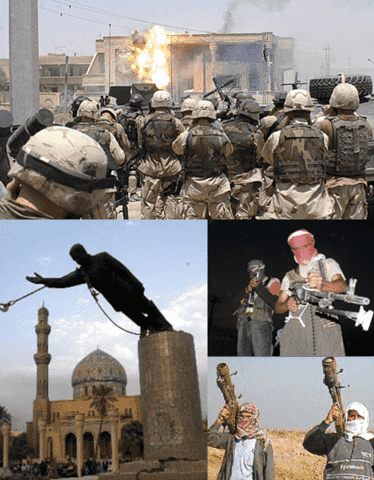The Iraq War, also known as the Second Gulf War or the Iraq Invasion, refers to the conflict that began in 2003 when the United States, along with a coalition of allied countries, launched a military invasion of Iraq. Here’s an overview of the Iraq War, including its history, key players, and lessons learned:
1. Background:
- The Iraq War was preceded by a series of events, including the 1990-1991 Gulf War (Operation Desert Storm), which resulted in a ceasefire and the imposition of United Nations sanctions on Iraq.

- The primary reasons cited for the 2003 invasion were the belief that Iraq possessed weapons of mass destruction (WMDs), concerns about Saddam Hussein’s regime, and the desire to promote democracy in the region.
2. Key Players:
- United States: Led by President George W. Bush, the United States played a central role in the decision to invade Iraq. Key officials included Vice President Dick Cheney, Secretary of Defense Donald Rumsfeld, and Secretary of State Colin Powell.
- United Kingdom: Under Prime Minister Tony Blair, the United Kingdom was the United States’ primary ally in the invasion.
- Coalition of the Willing: A coalition of countries, including Australia, Poland, and Spain, joined the U.S.-led invasion.
- Iraq: Led by President Saddam Hussein, the Iraqi government was the target of the invasion.
- United Nations: The United Nations played a role in diplomatic efforts, and weapons inspections were conducted by UN inspectors led by Hans Blix.
- Anti-war Protests: There were widespread anti-war protests worldwide, with millions of people expressing opposition to the invasion.
3. Invasion and Occupation:
- On March 20, 2003, the United States, with support from the coalition, launched the invasion of Iraq. The goal was to topple Saddam Hussein’s regime and locate and eliminate any alleged WMDs.
- The invasion quickly led to the fall of Baghdad, and Saddam Hussein’s government was officially ousted in April 2003.
- The period following the invasion saw the U.S. and its allies occupying Iraq and attempting to stabilize the country.
4. Post-Invasion Challenges:
- The aftermath of the invasion brought numerous challenges, including sectarian violence, insurgency, and a power vacuum.
- The U.S.-led Coalition Provisional Authority governed Iraq temporarily, but the transition to a stable government proved difficult.
5. Controversies and Lessons Learned:
- The Iraq War remains highly controversial and has been the subject of significant debate and scrutiny.
- Weapons of Mass Destruction: No substantial evidence of active WMD programs was found, undermining a central premise for the invasion.
- Intelligence Failures: The reliance on flawed intelligence assessments raised questions about the decision-making process leading to the war.
- Sectarian Conflict: The war exacerbated sectarian tensions between Sunni and Shia Muslims and contributed to years of violence in Iraq.
- Civilian Casualties: The war resulted in a significant number of civilian casualties, and there were allegations of human rights abuses by coalition forces.
- Post-Invasion Planning: Critics argue that insufficient planning for post-invasion governance and reconstruction contributed to instability.
- Legacy: The Iraq War’s legacy includes a destabilized Middle East, strained international relations, and a lasting debate over the use of military force.
6. Withdrawal and Aftermath:
- The U.S. gradually withdrew its troops from Iraq, with the last combat troops leaving in 2011. However, the security situation remained fragile.
- Iraq continued to face challenges, including political instability, violence, and the rise of extremist groups like ISIS.
In summary, the Iraq War was a complex and controversial conflict with far-reaching consequences. It raised questions about the use of military force, intelligence assessments, and the challenges of post-conflict stabilization and reconstruction. The legacy of the war continues to shape discussions on foreign policy and military intervention in the 21st century.











